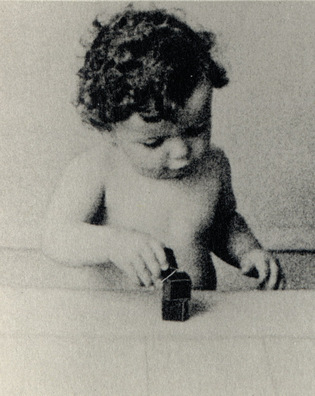 loading
loading
Arts & CultureObject lessonBuilding blocks Fred R. Volkmar is the Irving B. Harris Professor of Child Psychiatry, Pediatrics, and Psychology; the director of the Yale University Child Study Center; and the chief of child psychiatry at Yale–New Haven Hospital.  Atlas of Infant BehaviorThe 56-week-old child in this still was one of several filmed by Yale psychologist Arnold Gesell for his Atlas of Infant Behavior (1934)—the original medical guide to the developmental milestones of childhood. View full image
Give a one-year-old a pile of blocks, and, chances are, he’ll build a small tower. Parents, of course, have long known this from personal experience. But it wasn’t until 1934, with the publication of Arnold Gesell’s landmark Atlas of Infant Behavior, that anyone had systematically recorded such behaviors to create a guide for physicians and child psychologists, setting out the normal range of behaviors for healthy infants at every age. Originally trained as a teacher, Gesell ’15MD was one of the first students to obtain a PhD in the new field of child psychology. He was recruited to Yale in 1911, to start a clinic that then became the Child Study Center, and began a series of studies of infants and young children. His goal was to show the range of behaviors in normally developing children so clinicians could better identify children with developmental delays. His work was highly innovative for the time. Rather than rely solely on questionnaires or parent reports, Gesell actually observed children and used then-emerging technologies to more objectively capture what he saw: he used a movie camera to capture exactly how children approached tasks and how their approaches changed with age. He often filmed in the subjects’ homes or behind one-way mirrors, to ensure that observation be as unobtrusive as possible. The Atlas, a two-volume book totaling 921 pages, documents these trends through a compilation of film stills from Gesell’s recordings of children performing a series of activities at each developmental stage. It was a massive enterprise, designed to reveal the range of normative activities at a number of different ages and with many different tasks. There are images of children putting rattles in their mouths, ringing bells, playing with blocks, and putting together puzzles, along with associated commentary. The Atlas illustrates that a 24-week-old will play with only one block; a 32-week-old will hold one in each hand; and a 56-week-old (as shown here) will take the blocks and stack them into a tower. Gesell’s work had a profound impact not just in child psychology, but also pediatrics, by emphasizing the importance of developmental monitoring and of the pediatrician’s understanding of normal developmental processes. The emphasis on understanding landmarks continues to be used by pediatricians today. After Gesell retired in 1948, his influence continued through the Atlas—which remained a useful reference volume for decades—and through his many students, including Benjamin Spock ’25, ’29Med, who had a major impact on parenting practices in the 1950s and 1960s. Gesell’s legacy at Yale remains very much alive at the Child Study Center, which continues to bring innovative methods to the study of children and their development.
The comment period has expired.
|
|